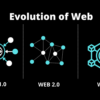Digital technologies play an increasingly structuring role in our democratic activities. Digital technology is not just a question of tools; it’s a veritable “culture” that is spreading through our societies, with its own imaginations, representations and values: collaboration, transparency, participation.
Neuromancer: The book that inspired Ghost in the Shell and Matrix, among others
The term cyberspace was popularized by American writer William Gibson[1], one of the leaders of the cyberpunk movement, in his novel Neuromancer (1984). Neuromancer is William Gibson’s first science fiction novel. It is generally regarded as the founding novel of the cyberpunk movement, having inspired many works such as the manga Ghost in the Shell and the film Matrix.
If the question of the machine, in its interaction with man, and the mutation it can produce, occupies a central place in a number of twentieth-century artistic movements, it constitutes the fundamental problematic of the Cyberpunk movement, for whom the machina is not just a device that can or cannot be used, but more profoundly an instrument of contamination that can threaten our society.
Cypherpunks: rebels with a cause – our privacy
Cypherpunks are not cyberpunks: while they are well aware of the dystopian scenarios that can result from technological evolution (particularly with regard to surveillance), they are not absolutely pessimistic. As a result, the cypherpunk movement is in some ways a reaction to cyberpunk, in that it postulates that technology can lead human beings to emancipation rather than mutual enslavement.
The cypherpunk movement was officially formed in September 1992 at a first meeting to discuss the implications of modern cryptography for the evolution of the world. Among them were Tim May[2], Eric Hughes[3] and John Gilmore[4]. Parodying Marx and Engels’ Manifesto of the Communist Party in his first sentence, Tim May read out his Crypto-Anarchist Manifesto[5], written four years earlier, in which he described the potential of cryptography and anonymity for individual emancipation. Openly anarcho-capitalist, the text praises the market and explains how this new technology would enable individuals to protect their freedom from the state:
Just as printing technology altered and reduced the power of medieval corporations and the social structure of power, cryptological methods fundamentally alter the nature of government and corporate interference in economic transactions.
Tim May, The Crypto Anarchist Manifesto, August 1988
Activist Judith Milhon[6] gives their name to cypherpunks. It’s a catchword based on the term cyberpunk, and made up of cipher (in the sense of secret code) and punk (thug). The name derives directly from the idea of cryptoanarchy. “I think you’re crypto-anarchists – what I’d call cypherpunks!” she’ll write. Many people got involved in the first few months, including such luminaries as phone hacker John Draper and cryptographers Hal Finney and David Chaum.
The Cypherpunks have structured their actions around five main themes :
- Software development, such as encrypted messaging, or the Tor project;
- Hardware;
- Expert panels and contributions to public consultations;
- Legal action;
- Civil disobedience.
- Développement logiciel, tel que les messageries cryptées, ou le projet Tor ;
- Matériel informatique ;
- Panels d’experts et contributions aux consultations publiques ;
- Actions judiciaires ;
Here we are faced with the problems of loss of privacy, deceptive computing, massive databases, increasing centralization – and David Chaum proposes a completely different direction to follow, one that puts power in the hands of individuals rather than those of states and large corporations. Computers can be used as a tool to liberate and protect people, rather than to control them.
– Hal Finney, email sent to the Cypherpunks community entitled “Why remailers…”, November 15, 1992
A few months later, in March 1993, Eric Hughes published the Cypherpunk Manifesto, the founding text of the movement’s philosophy. In May 1993, Cypherpunks made the cover of Wired magazine, recently founded to address the cultural, economic and political impact of emerging technologies. In particular, the Cypherpunks based their reflections on a long short story (cyberpunk avant l’heure) by Vernor Vinge, entitled True Names and published in 1980. It deals with the themes of anonymity, virtual worlds and technological singularity.[7].
[1] Timothy Christopher May, aka Tim May [1951 – 2018], b ” in Maryland (USA), is an American computer scientist, engineer and chief scientist at Intel at an early and crucial period in the company’s history.
[2] Eric Hughes is an American mathematician and computer programmer.
[3] John Gilmore, an American born in 1955, is one of the founders of the Electronic Frontier Foundation, the Cypherpunk mailing list and Cygnus Solutions.
[4] The Crypto Anarchist Manifesto: https://www.activism.net/cypherpunk/crypto-anarchy.html
[5] Jude Milhon, birth name Judith Milhon [1939 – 2003], born in Washington DC (USA), is an American hacker and author, also known by the pseudonym St. Jude.
[6] Eric Hughes is an American mathematician and computer programmer.
[7] The technological singularity is the hypothesis that the invention of artificial intelligence would trigger a runaway technological growth that would bring about unpredictable changes in human society.





